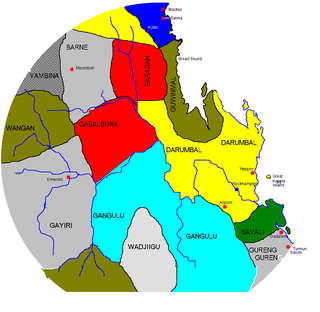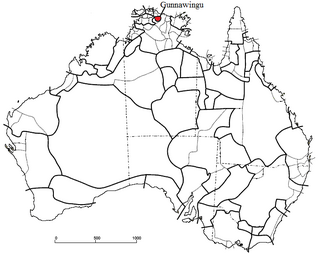Country
According to Norman Tindale's estimation, Ngiyampaa tribal lands extended over some 6,600 square miles (17,000 km2) in the territory lying south of the south bank of the Barwon and Darling rivers, from Brewarrina to Dunlop. Their area included Yanda Creek down to the source of Mulga Creek, and took in the Bogan River. The Wiradjuri were on their southeastern flank, the Gamilaraay northeast, while the Paakantyi lay to their west.

Norman Barnett Tindale AO was an Australian anthropologist, archaeologist, entomologist and ethnologist.

Barwon River, a perennial river that is part of the Murray–Darling basin, is located in the north-west slopes and Orana regions of New South Wales, Australia.

The Darling River is the third longest river in Australia, measuring 1,472 kilometres (915 mi) from its source in northern New South Wales to its confluence with the Murray River at Wentworth, New South Wales. Including its longest contiguous tributaries it is 2,844 km (1,767 mi) long, making it the longest river system in Australia.
This page is based on this
Wikipedia article Text is available under the
CC BY-SA 4.0 license; additional terms may apply.
Images, videos and audio are available under their respective licenses.
The Jawoyn, also written Djauan, are a group of Indigenous Australians living in the Northern Territory of Australia.
The Kurrama people are an indigenous Australian people from the Pilbara region of Western Australia.
The Bidjigal people are a group of indigenous Australians whose traditional lands are now described as western, north-western, south-eastern, and southern Sydney, in New South Wales, Australia.
The Amarak, also written Ngamarak, and now more commonly referred to as the Amurdak, are an indigenous Australian people of the Cobourg Peninsula in the Northern Territory.

The Kangulu, also written Gangulu, is an aboriginal tribe from the Mount Morgan area in Queensland, Australia.

The Gunwinggu people are a tribe of Australian Aboriginal people, forming part of the Bininj Gun-Wok peoples, who live to the east of Darwin, Northern Territory.

The Kureinji, otherwise known as the Keramin, are an Aboriginal group whose traditional lands are located in the Northern Riverina of southwest New South Wales, Australia.
The Nyawaygi, or by community preference Nywaigi, also spelled Nyawigi or Nawagi, are an Indigenous Australian peoples whose original country was Halifax Bay, North Queensland.
The Anēwan, also written Anaiwan/Anaywan, are the traditional owners of the land around Armidale and the New England tableland in New South Wales.
The Barindji, also written Parrintyi, are an indigenous Australian people of the state of New South Wales. They are to be neatly distinguished from the Paaruntyi, who spoke a similar language but whom they called the spitting people.
The Dhudhuroa people were an Indigenous Australian people of North-eastern Victoria, in the state of Victoria, Australia.
The Biria were an indigenous Australian people of Queensland.
The Weilwan are an indigenous Australian people of the state of New South Wales.
The Kwiambal were an indigenous Australian people of New South Wales.
The Kambure more commonly known now as Gamberre,were an indigenous Australian people of the Kimberley region of Western Australia.
The Marulta were an indigenous Australian people of the state of Queensland.
The Nggamadi were an indigenous Australian people of the Cape York Peninsula of northern Queensland.
The Yindjilandji are an indigenous Australian people of the Northern Territory.
The Gudanji, otherwise known as the Kotandji or Ngandji, are an indigenous Australian people of the Northern Territory.







